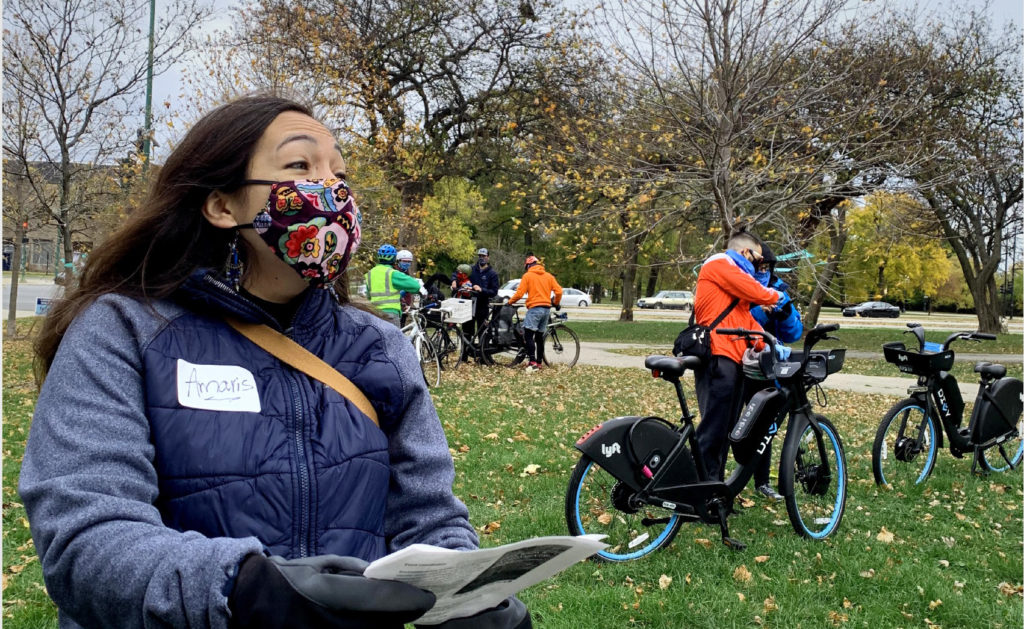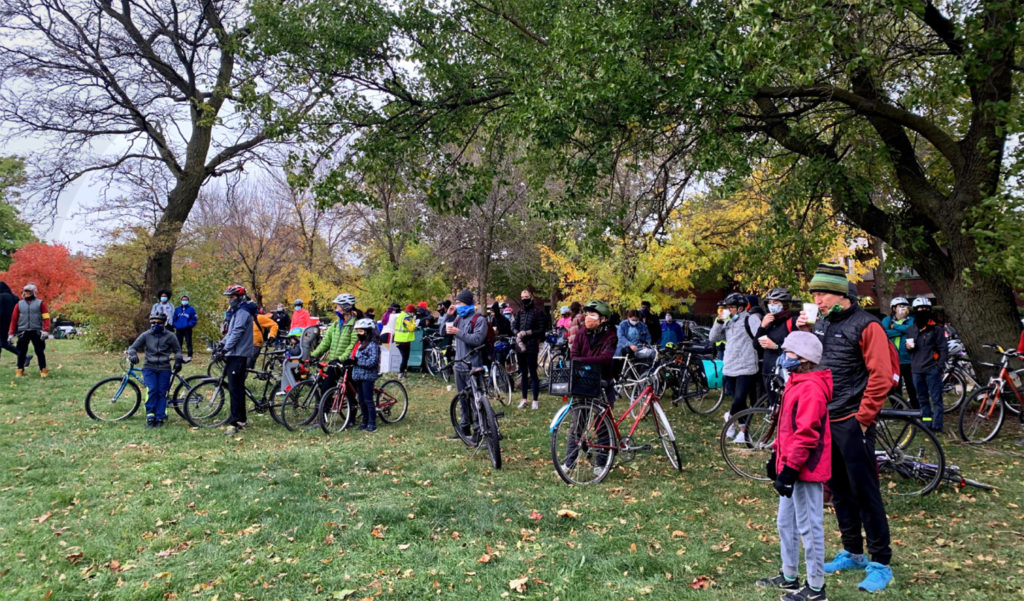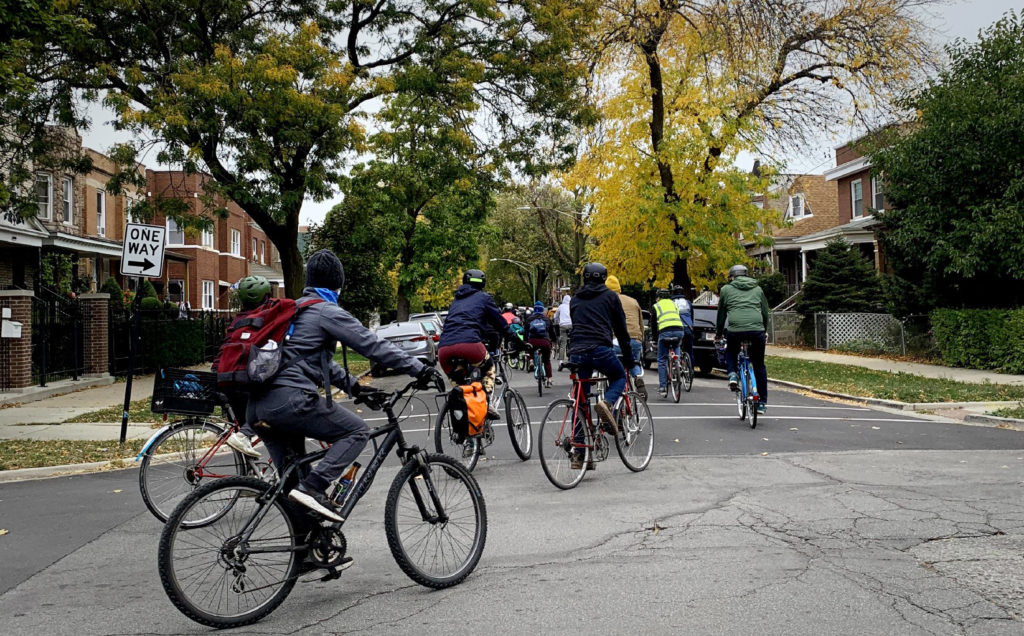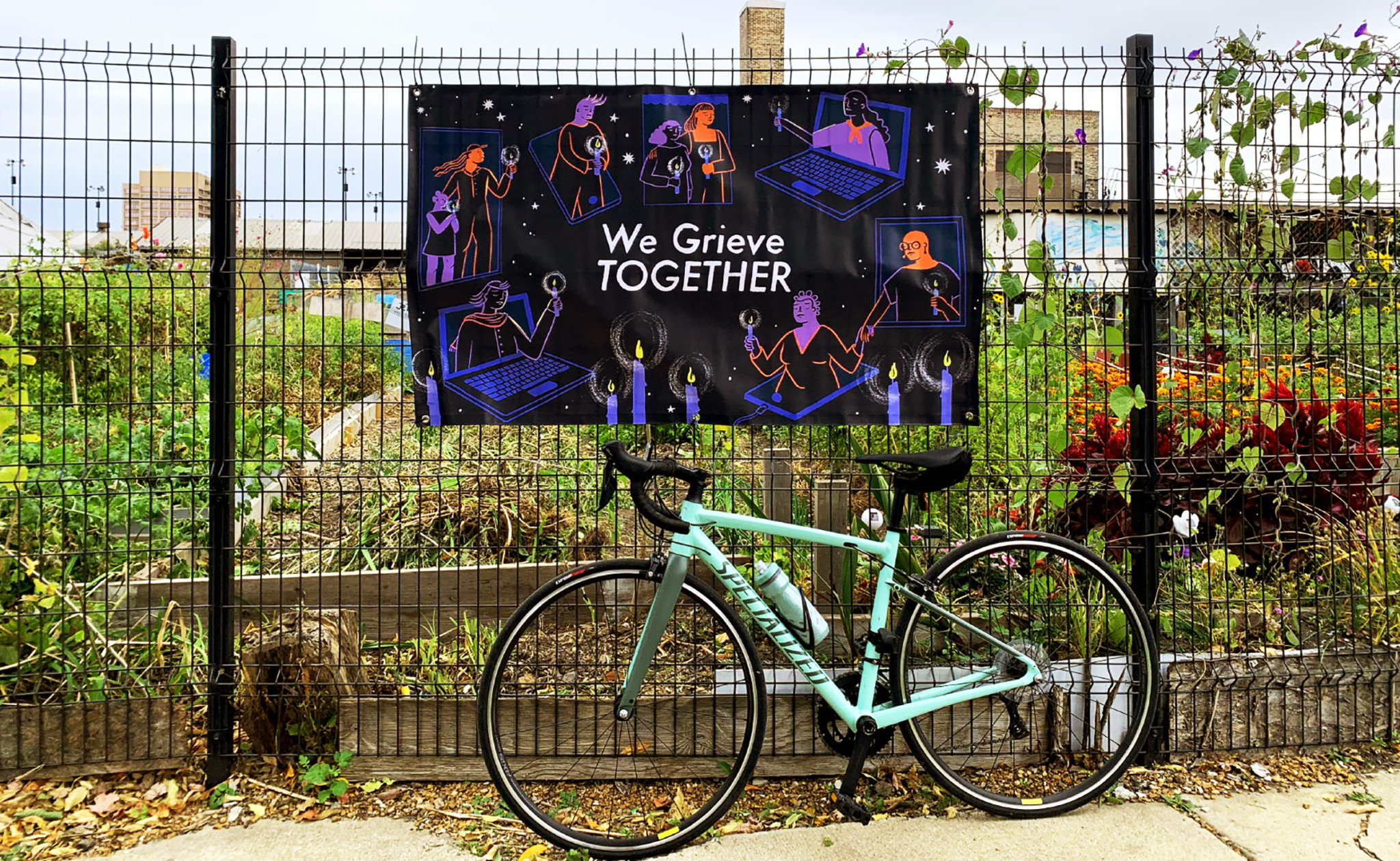On the morning of October 17—an overcast Saturday with an autumn chill already in the air—more than a hundred cyclists gathered on the corner of Albany and Ogden avenues in Douglass Park. Some clutched cups of champurrado for warmth, balancing their bikes against their hips and lifting their masks only to sip their drinks. Others wandered over to a folding table stacked with drawstring bags containing a pamphlet about the 2020 Census, a pedometer, a pen, a bright red birding guidebook in Spanish and English, and a blue bandana that read “Black and Brown Solidarity.” They were there for a bike ride through North Lawndale and Little Village dubbed “Bikes, Birds, and Environmental Justice.”
Participants came from all over the city and beyond. Juan Manuel Bustos, who lives in Hermosa, happened upon the event while on a morning bike ride. “I saw there was some food and it looked interesting to me, because I loved seeing the diversity. When the tsunami of bicycles came over here, I saw white people, Black people, Indigenous, brown; everybody all together, riding their bicycles.” Jamie Bush, a Little Village resident, said she heard about the ride through a friend of her husband’s at the Lawndale Christian Fitness Center. “We love birding and we love biking,” she said. “Social justice, environmental action, Black and brown solidarity—those are all things that we wanted to support.” Tiara Bullock, a high school senior and student journalist, drove from Lansing with her father to attend. She said she was excited to see different races and ethnicities collaborating and coming together. “It’s different from things that you see on the news,” Bullock said. “More positivity, less negativity.”
The event came together following an online panel co-presented by the One Earth Film Festival and Environmentalists of Color (EOC) earlier this summer. Aasia Mohammad Castañeda, a member of the EOC Advisory Council, said the organization helped curate a slate of panelists that highlighted different aspects of environmental justice, from bikes and urban agriculture to birding. Olatunji Oboi Reed, the founder, president, and CEO of Equiticity, an organization that promotes racial equity, was one of the panelists. “There was an environmental justice advocate, an ultrarunner, a birder, an urban farmer, and a cyclist,” he said. Some of the same people that were on the panel came together to make the Saturday bike ride happen, he said. Amaris Alanis Ribeiro, a board member of both EOC and Organic Oneness, first floated the idea of a birding and biking event. Castañeda suggested the focus on environmental justice. They also brought Syda Segovia Taylor, founder and executive director of Organic Oneness as well as a member of EOC, to the table after her organization helped coordinate a bike tour commemorating the 1919 Chicago riots in Bronzeville, Canaryville, and Bridgeport.

Organizers chose a route that went through both North Lawndale and Little Village because of the strong relationships they had with local community-based organizations, and also because of their demographics. North Lawndale is eighty-seven percent non-Latinx Black, and South Lawndale—the community area encompassing Little Village—is eighty-three percent Latinx. “We also wanted to focus on creating stronger bonds between Black and brown communities,” Reed said.
The event’s focus on Black and brown healing and solidarity was especially critical after Black Chicagoans faced attacks in predominantly Latinx communities in June, during the citywide uprisings that followed the police murders of George Floyd, Breonna Taylor, and Tony McDade. “We’ve made a lot of progress—a lot of organizations on both sides, a lot of violence interrupters on both sides, a lot of caring and concerned citizens on both sides strengthening those bonds and healing those divides,” Oboi said. “So, we wanted to bring another dimension of improving those relationships via a bike ride.”
Cyclists saw the event not only as an opportunity to demonstrate solidarity and allyship, but also as a space to build community. Chandra Christmas-Rouse, an urban planner and Equiticity board member, said she came to the event to meet other environmental justice advocates and community members dedicated to building solidarity across neighborhoods. “I’m interested in working with folks that are thinking about the role of food, the role of industrial pollution and policy, and how we can build solutions toward a more equitable future,” she said.
One of the event’s resounding themes was that any proposed path to a more equitable future must acknowledge and center Indigenous systems of knowledge. Before the group headed out, Castañeda spoke about Chicago’s ecosystems and waterways, and noted that Chicago is the traditional homeland of the Council of the Three Fires: Ojibwe, Odawa, and Potawatomi—as well as the Miami, Ho-Chunk, and Menominee Nations. Chicago is home to over 22,000 Native Americans. The greater metropolitan area is home to over 65,000 Native Americans from 175 tribal nations. “We acknowledge that the treaties made with the people of the Three Fires have not been honored, and the destruction and dispossession of the land and lives of Indigenous peoples continues until this day,” Castañeda told the crowd. “We acknowledge that acts of genocide, deceit, forced removal, dispossession, appropriation of their knowledge systems, and implementation of a settler-colonial structure formed the foundation or our current city. We acknowledge that colonialism is an ongoing structure.”

Throughout the ride, the planning team and speakers returned to the idea that structural racism was at the heart of all environmental, food, and mobility injustices. “Our oppression was—and is—by design,” Reed said. Christmas-Rouse reflected on the ways in which structural racism manifested in urban planning policies in her neighborhood, Bronzeville. “I think about the destruction of public housing that took place. And I think that the conditions that lead to that demolition, and the type of structures that kept people in those communities, are all a part of environmental racism, because it impacted the quality of health and the quality of environment in that community,” she said.
Reed said he believes that community bike rides get us a step closer to envisioning a society where Black, brown, and Indigenous people thrive. “Community rides at first glance could be perceived as frivolous—just people having fun. However, the impact is much more vast,” he said. “It speaks directly to improving people’s health because they’re being more physically active; reducing violence, because trust is at a higher level; and people have less concerns about violence and that allows people to walk and bike more in our neighborhoods. [If there are] more people walking and biking in neighborhoods, the more retail is attracted to a neighborhood. And retail brings with it jobs.”
Edith Tovar, an organizer with Little Village Environmental Justice Organization (LVEJO) emphasized the need for this kind of mobility justice in Little Village specifically. Many Little Village residents ride bikes, she said, but there just isn’t much infrastructure in the neighborhood to support that activity. According to the Chicago Data Portal and Chicago Complete Streets, there are only two marked bike lanes in Little Village: one going east to west on 26th Street, and another going north to south on Central Park Avenue. And any new industrial development would only make it worse. “Initially in the planning conversation, I was nervous about folks taking their bikes on 31st Street,” she said. “31st Street is the street that divides industry and residential area, and there isn’t much space. If we continue to allow warehouse developments to pop up in my neighborhood, that’s only going to make it harder to have bike infrastructure.”
Reed said he hoped cyclists who participated in the ride would become more aware of and invested in the power of independent mobility. “Oftentimes, we bike for specific reasons: recreation, exercise, transportation—and that’s fine. That is transformative in itself,” he said. “However, I also wanted people to begin to understand the role of bikes in improving our neighborhoods. We engage each other more. We become socially cohesive. We create more collective efficacy. We trust each other more. There’s a social dynamic that is happening on these community rides.”
The day began with birding activities led by staff from Audubon Great Lakes. Participants, equipped with binoculars and field guides, wandered the park on the lookout for song, swamp, or white-throated sparrows—just a few of the dozens of species of birds that migrate through Douglass Park every fall. “[Birders] get to see a part of [Douglass Park] that is not seen easily,” Reed said. “You have to venture into the interior. Just driving by or walking down the edges does not allow you to appreciate what that park has to offer.”
At 10am, the ride rolled out—a joyful, motley crew moving west on tree-lined Douglas Blvd. Reed led the way, funk music booming from a speaker strapped to a dolly attached to his bike. Cyclists whooped and waved to residents putting up Halloween decorations on Central Park Avenue as we turned right for our first stop: the African Heritage Garden on West 12th Place, which highlights plants that originated on the continent. As the last of the cyclists had rolled to a stop, Blanche Killingsworth, the chair of the North Lawndale Historical and Cultural Society (NLHCS), greeted the group.
“North Lawndale is rich in history,” Killingsworth said. “I welcome you to our ground. You are home.” Today, some 35,000 Chicagoans, eighty-seven percent of whom are Black, live in the neighborhood. “But originally, North Lawndale was a Czechoslovakian community,” Killingsworth said later. “Then, it became a Jewish community. At one time, North Lawndale had the most synagogues of any place in the city.” She shared examples of famous people and places in the community: the historic Stone Temple Baptist Church, where Martin Luther King Jr. spoke when he came to Chicago; the Contract Buyers League, a grassroots organization that fought redlining and housing discrimination; the longest stretch of Route 66 in a residential neighborhood; and Michael Scott, the past President of the Board of Education.
But North Lawndale’s story is also one of structural dispossession. “The City of Chicago—ever since the ‘68 riots—has left North Lawndale on the table, just like Englewood and Garfield,” Killingsworth said. “When the stores left—places where you could buy meat and fish—it left North Lawndale like a food desert.” As of June, there were only a handful of large grocery stores in North Lawndale. And between 2015 and 2016, researchers at the Sinai Urban Health Institute estimated that over a third of North Lawndale households potentially experienced food insecurity. “When I speak about the conditions of North Lawndale, it’s a disinvestment.” She repeated the words to let them sink in. “It’s a disinvestment.”

A second wave of disinvestment hit North Lawndale during the Great Recession. “When the foreclosure hit North Lawndale, it hit it hard,” Killingsworth said. “A lot of banks took over buildings, but they didn’t maintain them. But they maintained them in other neighborhoods: Bucktown, Uptown, the Gold Coast. There are abandoned buildings or foreclosed properties up there, but look at the condition of them,” she said. “Who takes care of them? The banks do. They aren’t even allowed to board them up on the North Side. You just see a ‘For Sale’ sign, or you see a lock on the door. But in a neighborhood like North Lawndale, you see all these boarded up, beautiful graystone buildings—those are beautiful buildings. The banks don’t do that.
“After the ‘68 riots and the city didn’t invest in North Lawndale, the mayor at the time said, ‘tear it up and tear it down.’ ” North Lawndale has 1,355 vacant lots—the third-most by community area in the city, behind Englewood (1,943) and New City (1,371). Killingsworth explained to the gathered cyclists that the now-lush Africa Heritage Garden used to be one of those lots. “A lot of the trees were torn down. There were no trees—none of that out there. It was just vacant land.” And all of those vacant lots impacted Lawndale residents’ mental health. “When one has to pass by a vacant lot with trash, no buildings, or with abandoned buildings, it gives a person stress,” Killingsworth said. “But when you go to places like Oak Park, there’s a canopy of trees on every block.”
According to the US Geological Survey, in 2011 North Lawndale’s green index—the percent of land covered by vegetation —was zero, but the neighborhood now boasts more than twenty community gardens. “There’s a big movement around gardening and green spaces, to provide public spaces and green spaces for people in the community to enjoy and be outside,” said John Wolf, a board member of the North Lawndale Historical and Cultural Society. The movement is thanks in part to the North Lawndale Greening Committee, an organization whose mission is to create a “greener, healthier, and safer community where people of all ages have places to meet and play as they build a stronger sense of community.” And getting residents into gardens plays a significant role. “I am from the South,” Killingsworth said. “And I tell people when you take a little, bitty seed and put it in the ground and you see it flourish and then ascend to something that you can eat, you get a certain amount of pride. It helps you respect nature.”
While the African Heritage Garden produces some fruit, it is primarily a “sitting garden,” unlike the Semillas de Justicia garden—our second stop. Paintings with captions such as “We Grieve Together” and “Nadie Es Ilegal En Tierras Robadas” (“Nobody is Illegal on Stolen Land”) line the garden fences.
Sergio Ruiz, an organizer with LVEJO who welcomed the group to the garden, told the Weekly that the art is a departure from the themes that had previously adorned the garden. “We transferred from regular decorative paintings to paintings that address things in the Latinx community that has to do with anti-Black racism and unlearning stuff—alerting people to what’s actually going on in the world,” he said.
LVEJO’s ongoing food justice campaign focuses on encouraging “a sense of independence and self-determination through the food that [people] grow, sell, and consume, so that [they] can be self-sustainable as a neighborhood,” Ruiz said. He later told the Weekly that part of the reason LVEJO focuses on food justice is because “there’s not really a lot of healthy options” in the community. (According to a recent study, over forty-four percent of Chicagoans living in South Lawndale experienced food insecurity between 2015 and 2016.) In addition to the garden, LVEJO’s Farm, Food, Familias (Granja, Comida, Familia) initiative provides local chef-cooked meals to families in Little Village.
Semillas de Justicia also helps residents heal by getting in touch with their roots. “Part of gardening and farming is a practice that we have that has a long history,” Ruiz said. The gardeners always seem to say the same thing, he noted: “that we ourselves, in this community, created our own safe space. The harvest we have here is grown with whole care, for our workers—all workers—and animals and lands.” Killingsworth described a similar connection between ancestral land practices and healing with the African Heritage Garden. “The elders walked the grounds with sage and blessed them,” she said. “I consider this a spiritual and holistic ground.” Castañeda added that food justice must build off the work of the ancestral stewards of the land and the ways they cared for it. “Indigenous foodways are archives of ancestral knowledge,” she said, “and this is part of our healing.”
Food justice and healing also require equitable policies. “There are so many Black and brown farmers and growers that are trying to be successful,” Castañeda said. “There are so many barriers, and this system is not set up [for them]. The more we can course-correct policy, legislation, and processes for brown and Black food and farm businesses and cooperatives, the healthier our communities will be.”
The ride’s final stop was the demolition site of the former Crawford coal plant. Tovar explained that for years the plant’s presence played a role in many premature deaths and emergency room visits due to respiratory issues within the Little Village community, and that shutting it down took a twelve-year campaign. “The city engaged Little Village residents about what they wanted to see,” she continued. “Unfortunately, HILCO developers did not.” In April, Hilco Redevelopment Partners demolished the Crawford smokestack in an operation that covered the neighborhood in a thick layer of dust. At least two area residents have died as a result of Hilco’s work; one was a worker who fell to his death at the site in 2019; the other was an elderly man with pulmonary disease who died shortly after the April implosion.
Tovar encouraged the group to draw connections between environmental injustice in Little Village and in North Lawndale. “Air is not stagnant,” she told the Weekly. “The fight is not only in Little Village, but in North Lawndale as well. We all need air to breathe.”
Charmaine Runes is a developer, designer, and journalist studying Computational Analysis and Public Policy at the University of Chicago. She last wrote about COVID-19 in an illustrated FAQ for the Weekly.

